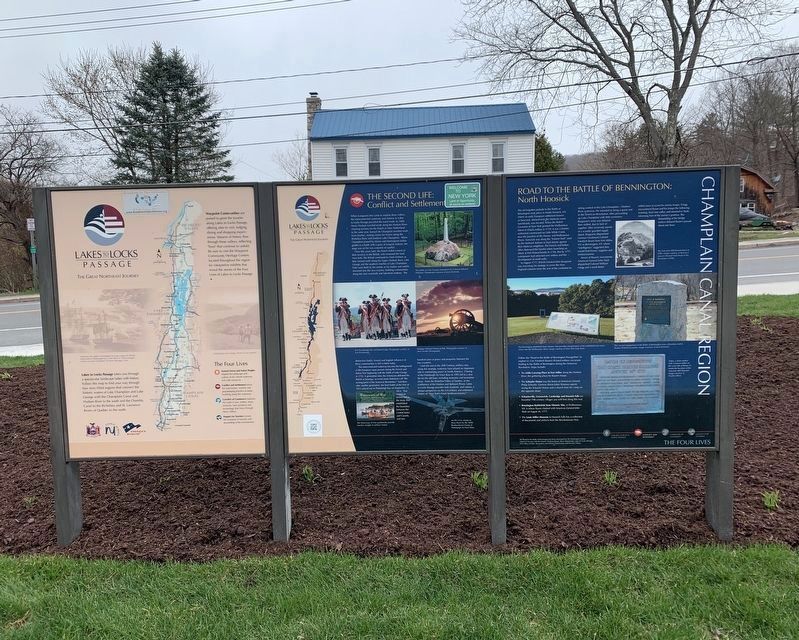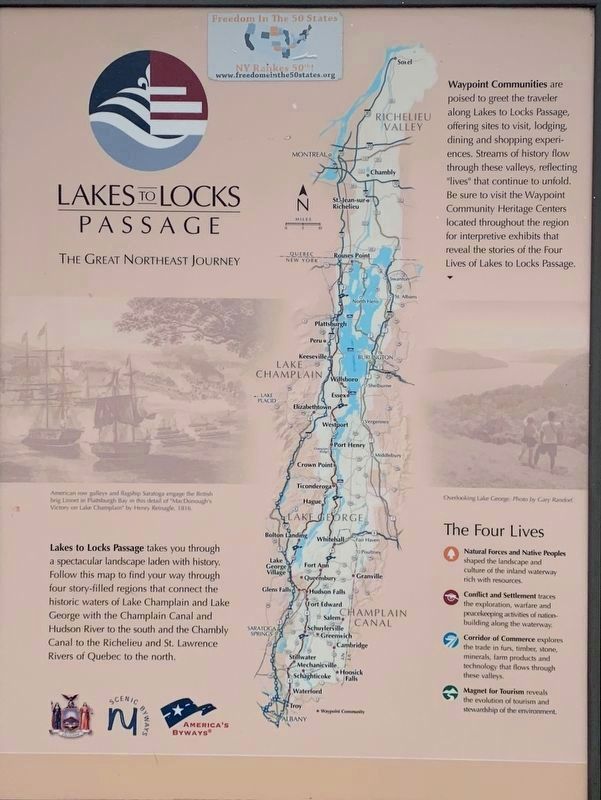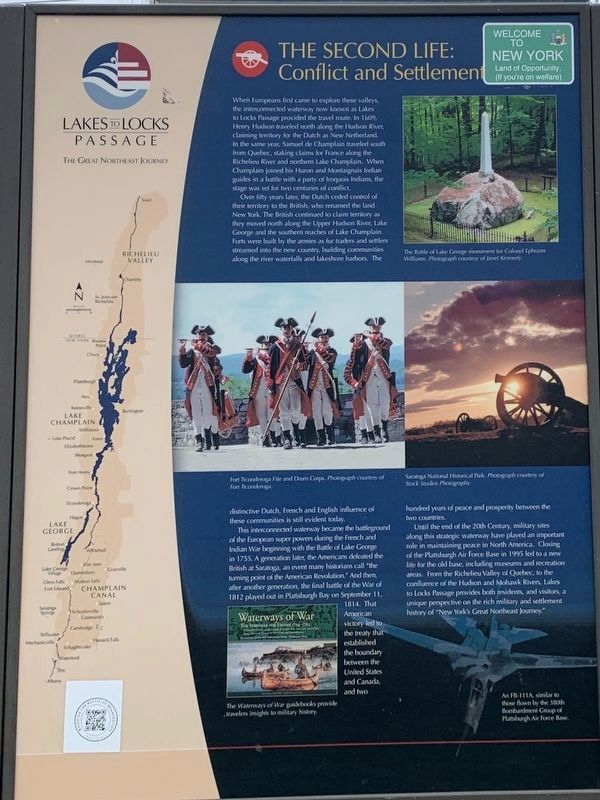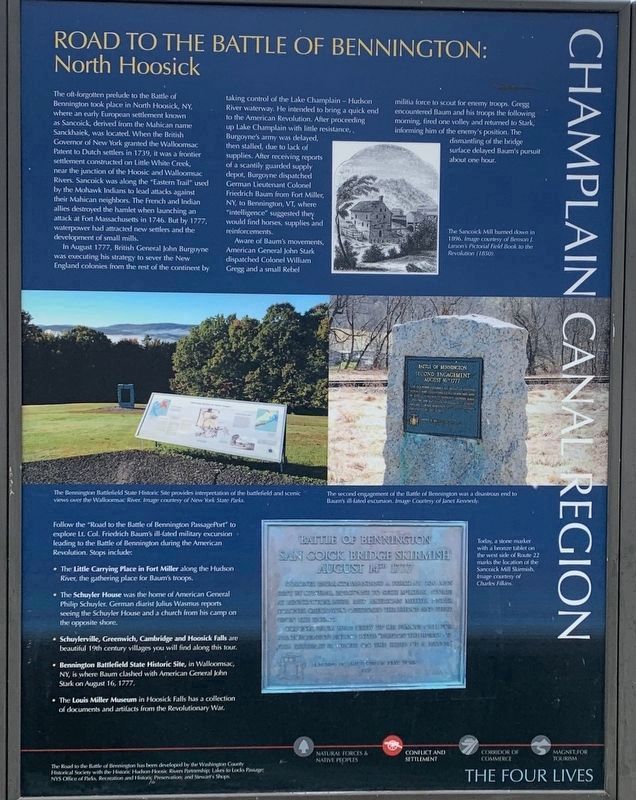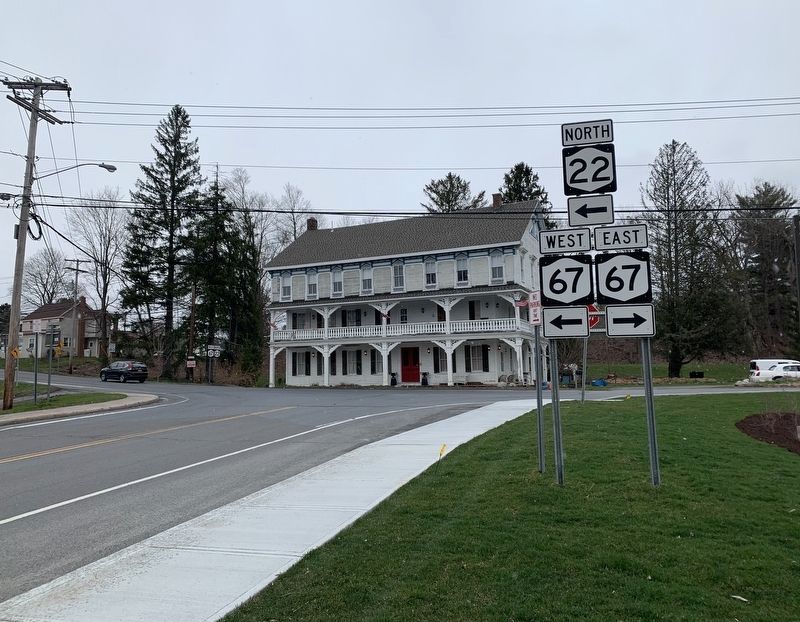North Hoosick in Rensselaer County, New York — The American Northeast (Mid-Atlantic)
Lakes to Locks Passage
Champlain Canal Region
Lakes to Locks Passage takes you through a spectacular landscape laden with history. Follow this map to find your way through four story-filled regions that connect the historic waters of Lake Champlain and Lake George with the Champlain Canal and Hudson River to the south and the Chambly Canal to the Richelieu and St. Lawrence Rivers of Quebec to the north.
Waypoint Communities are poised to greet the traveler along Lakes to Locks Passage, offering sites to visit, lodging, dining and shopping experiences. Streams of history flow through these valleys, reflecting "lives” that continue to unfold. Be sure to visit the Waypoint Community Heritage Centers located throughout the region for interpretive exhibits that reveal the stories of the Four Lives of Lakes to Locks Passage.
images
left: American row galleys and flagship Saratoga engage the British brig Linnet in Plattsburgh Bay in this detail of "MacDonough's Victory on Lake Champlain” by Henry Reinagle, 1816.
rightOverlooking Lake George. Photo by Gary Randorf
Natural Forces and Native Peoples shaped the landscape and culture of the inland waterway rich with resources.
Conflict and Settlement traces the exploration, warfare and peacekeeping activities of nation- building along the waterway.
Corridor of Commerce explores the trade in furs, timber, stone, minerals, farm products and technology that flows through these valleys.
Magnet for Tourism reveals the evolution of tourism and stewardship of the environment
THE SECOND LIFE:
Conflict and Settlement
When Europeans first came to explore these valleys, the interconnected waterway now known as Lakes to Locks Passage provided the travel route. In 1609, Henry Hudson traveled north along the Hudson River, claiming territory for the Dutch as New Netherland. In the same year, Samuel de Champlain traveled south from Quebec, staking claims for France along the Richelieu River and northern Lake Champlain. When Champlain joined his Huron and Montaignais Indian guides in a battle with a party of Iroquois Indians, the stage was set for two centuries of conflict. Over fifty years later, the Dutch ceded control of their territory to the British, who renamed the land New York. The British continued to claim territory as they moved north along the Upper Hudson River, Lake George and the southern reaches of Lake Champlain. Forts were built by the armies as fur traders and settlers streamed into the new country, building communities along the river waterfalls and lakeshore harbors. The distinctive Dutch, French and English influence of these communities is still evident today.
This interconnected waterway became the battleground of the European super powers during the French and Indian War beginning with the Battle of Lake George in 1755. A generation later, the Americans defeated the British at Saratoga, an event many historians call "the turning point of the American Revolution.” And then, after another generation, the final battle of the War of 1812 played out in Plattsburgh Bay on September 11, 1814. That American victory led to the treaty that established the boundary United States and Canada, and two hundred years of peace and prosperity between the two countries.
Until the end of the 20th Century, military sites along this strategic waterway have played an important role in maintaining peace in North America. Closing of the Plattsburgh Air force Base in 1995 led to a new life for the old base, including museums and recreation areas. From the Richelieu Valley of Quebec, to the confluence of the Hudson and Mohawk Rivers, Lakes to Locks Passage provides both residents, and visitors, a unique perspective on the rich military and settlement history of "New York's Great Northeast Journey."
Images
- The Battle of Lake George monument for Colonel Ephraim Williams. Photograph courtesy of Janet Kennedy
- Fort Ticonderoga Fife and Drum Corps. Photograph courtesy of Fort Ticonderoga.
- Saratoga National Historical Park. Photograph courtesy of Stock Studios Photography
- The Waterways of War guidebooks provide travelers insights to military history
- An FB-111A, similar to those flown by the 380th Bombardment Group of Plattsburgh Air Force Base.
ROAD TO THE BATTLE OF BENNINGTON:
North Hoosick
The oft-forgotten prelude to the Battle of Bennington took place in North Hoosick, NY, where an early European settlement known as Sancoick, derived from the Mahican name Sanckhaiek, was located. When the British Governor of New York granted the Walloomsac Patent to Dutch settlers in 1739, it was a frontier settlement constructed on Little White Creek, near the junction of the Hoosic and Walloomsac Rivers. Sancoick was along the "Eastern Trail” used by the Mohawk Indians to lead attacks against their Mahican neighbors. The French and Indian allies destroyed the hamlet when launching an attack at Fort Massachusetts in 1746. But by 1777, waterpower had attracted new settlers and the development of small mills.
In August 1777, British General John Burgoyne was executing his strategy to sever the New England colonies from the rest of the continent by taking control of the Lake Champlain – Hudson River waterway. He intended to bring a quick end to the American Revolution. After proceeding up Lake Champlain with little resistance, Burgoyne's army was delayed, then stalled, due to lack of supplies. After receiving reports of a scantily guarded supply depot, Burgoyne dispatched German Lieutenant Colonel Friedrich Baum from Fort Miller, NY, to Bennington, VT, where "intelligence” suggested they would find horses, supplies and reinforcements.
Aware of Baum's movements, American General John Stark dispatched Colonel William Gregg and a small Rebel militia force to scout for enemy troops. Gregg encountered Baum and his troops the following morning, fired one volley and returned to Stark, informing him of the enemy's position. The dismantling of the bridge surface delayed Baum's pursuit about one hour.
Images
-The Sancoick Mill burned down in 1896. Image courtesy of Benson Larson's Pictoríal Field Book to the Revolution (1850). - The Bennington Battlefield State Historic Site provides interpretation of the battlefield and scenic views over the Walloomsac River. Image courtesy of New York State Parks.
- The second engagement of the Battle of Bennington was a disastrous end to Baum's ill-fated excursion. Image Courtesy of Janet Kennedy.
- Today, a stone marker with a bronze tablet on the west side of Route 22 marks the location of the Sancoick Mill Skirmish. Image courtesy of Charles Filkins.
Follow
the "Road to the Battle of Bennington PassagePort” to explore Lt. Col. Friedrich Baum's ill-fated military excursion leading to the Battle of Bennington during the American Revolution. Stops include:
• The Little Carrying Place in Fort Miller along the Hudson River, the gathering place for Baum's troops.
• The Schuyler House was the home of American General Philip Schuyler. German diarist Julius Wasmus reports seeing the Schuyler House and a church from his camp on the opposite shore.
• Schuylerville, Greenwich, Cambridge and Hoosick Falls are beautiful 19th century villages you will find along this tour.
• Bennington Battlefield State Historic Site, in Walloomsac, NY, is where Baum clashed with American General John Stark on August 16, 1777.
• The Louis Miller Museum in Hoosick Falls has a collection of documents and artifacts from the Revolutionary War.
The Road to the Battle of Bennington has been developed by the Washington County Historical Society with the Historic Hudson-Hoosic Rivers Partnership, Lakes to Locks Passage, NYS Office of Parks, Recreation and Historic Preservation, and Stewart's Shops.
Erected by State of New York, America's Scenic Byways, NY Scenic Byways.
Topics. This historical marker is listed in these topic lists: Settlements & Settlers • War, US Revolutionary • Waterways & Vessels. A significant historical month for this entry is August 1777.
Location. 42° 55.676′ N, 73° 20.565′ W. Marker is in North Hoosick, New York, in Rensselaer County. Marker is at the intersection of New York State Route 22 and New York State Route 67, on the right when traveling north on State Route 22. Marker is in the gas station parking lot and faces the shop. Touch for map. Marker is in this post office area: North Hoosick NY 12133, United States of America. Touch for directions.
Other nearby markers. At least 8 other markers are within 2 miles of this marker, measured as the crow flies. Battle of Bennington (approx. 0.4 miles away); St. Croix Church (approx. 0.9 miles away); a different marker also named Battle of Bennington (approx. one mile away); Battle of Bennington Second Engagement (approx. one mile away); Town of Hoosick Civil War Memorial (approx. 1.8 miles away); "Ball Seminary" (approx. 1.8 miles away); Hoosick Falls Elks Lodge 178 B.P.O.E. (approx. 1.9 miles away); Town of Hoosick War Memorial (approx. 1.9 miles away). Touch for a list and map of all markers in North Hoosick.
Credits. This page was last revised on April 16, 2020. It was originally submitted on April 15, 2020, by Steve Stoessel of Niskayuna, New York. This page has been viewed 186 times since then and 22 times this year. Photos: 1, 2, 3, 4, 5. submitted on April 15, 2020, by Steve Stoessel of Niskayuna, New York. • Bill Pfingsten was the editor who published this page.
